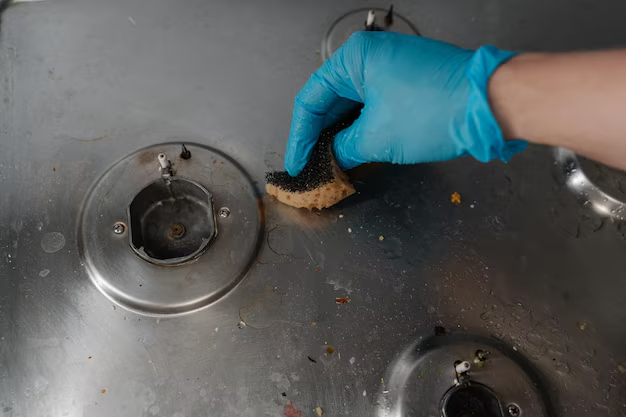Mastering Fridge Maintenance: Unclog Your Refrigerator Drain Line Like a Pro
There's a moment every homeowner dreads — that unexpected puddle of water pooling beneath your refrigerator. While a myriad of issues could be at play, a clogged refrigerator drain line often tops the list. Understanding how to clean this tiny but crucial component can save you time, money, and frustration. Let's delve into the art of maintaining this essential feature of your fridge to keep it in top shape.
The Role of the Refrigerator Drain Line
Cooling Efficiency and Moisture Management
Your refrigerator is more than a cold box. It's an intricate system designed to store food optimally. A vital aspect of this system is humidity control, which the drain line manages by channeling excess condensation away from your food. This ensures your fridge isn’t just cool but balanced in moisture levels — critical for reducing spoilage.
Common Drain Line Problems
Like any component with a thankless job, the drain line occasionally struggles. Over time, it might become clogged with food particles, debris, or ice. When this happens, the symptoms — puddles inside the fridge, icy formations, or dripping sounds — are usually inconvenient but straightforward to resolve if you know where to start.
Unveiling the Iceberg: Symptoms of a Clogged Drain Line
- Water Accumulation: Puddles at the bottom of the refrigerator or on the floor are clear signs.
- Icy Interior Surfaces: Ice buildup despite a closed door might point towards drainage issues.
- Unusual Noises: New gurgling or dripping sounds can be indicative of water struggling to escape.
- Musty Odors: Stagnant water can lead to unpleasant smells emanating from the fridge.
Prepping for Success: Cleaning Your Drain Line
Safety First
Before diving into your fridge, take essential safety measures:
- Unplug the Appliance: Always disconnect from power to prevent electric shock.
- Clear and Empty the Fridge: Not only is it easier to work with an uncluttered appliance, but it also prevents accidental contamination of food.
Tools of the Trade
- Flexible Wire or Drain Snake: Perfect for clearing obstructions.
- Warm Water: A gentle nudge to stubborn ice or debris.
- Baking Soda and Vinegar: A natural cleaning duo that deodorizes and dislodges clogs.
- Towel or Sponges: For wiping away moisture during the process.
Step-by-Step Guide to Clear a Clogged Drain
Locate the Drain Hole: Usually found at the back of the fridge interior.
Inspect and Remove Debris: Carefully check for visible blockages. A tool like a slim wire or drain snake can manually remove clogs.
Flush the Drain: Mix warm water with baking soda, then gently pour it down the drain to dislodge any remaining bits. Follow with a vinegar rinse to clean and deodorize.
Test the Drainage: Pour a small amount of water in and check for successful drainage. If water flows effortlessly, your work here is done!
Reassemble and Plug Back In: Ensure everything is secure and operational. It might take up to 24 hours for the fridge to reach optimal cooling temperatures again.
Beyond Basics: Troubleshooting Persistent Problems
Exploring Other Causes
If your efforts don’t clear the problem, or it repeats frequently, explore these possibilities:
- Defrost Timer Malfunction: A poorly timed defrost cycle can lead to ice buildup, restricting water flow.
- Defective Drain Pan: Located beneath the fridge, if it’s damaged, water flow might be hindered.
- Environmental Humidity: High levels can overwhelm the drain line. Installing a dehumidifier near the refrigerator might assist in extreme conditions.
Keep it Clear: Drain Line Maintenance Tips
Routine Checkups
Stay ahead by making regular drain line inspection part of your housekeeping routine. A monthly visual check can catch clogs before they become issues.
Frequent Flushes: Even when working perfectly, a little preventive maintenance with warm water keeps things running smoothly.
Debris-Free Fridge: Always ensure food items are properly sealed and contained; crumbs are the common offenders for clogs.
Eco-Friendly Tips
Natural Deterrents: Regular use of vinegar maintains cleanliness without the environmental impact of chemical cleaners.
Mind the Energy Use: A well-maintained fridge is an energy-efficient one — keeping the drain clean means it works less to achieve coolness, saving you energy.
Key Takeaways for a Cleaner Fridge 🧽
It's an empowering skill-set to manage small appliance woes on your own. Here’s a quick recap of the essentials:
- 🧰 Safety First: Always prioritize unplugging your appliance before maintenance.
- 💧 Recognize the Signs: Look out for water puddles, ice buildup, or unusual sounds.
- 🧼 Tidy Tactics: Use warm water, baking soda, and vinegar for a natural clean.
- 🔍 Regular Checks: Monthly inspections keep drain lines free-flowing and effective.
- ♻️ Eco-Friendly Choices: Opt for natural cleaning to maintain efficiency and be kind to the environment.
By understanding these aspects of refrigerator care, you not only extend the lifespan of your appliance but also enhance its performance — preserving the freshness of your groceries with ease. Whether it's managing humidity or tackling unexpected leaks, you've got the knowledge to handle your fridge's needs with confidence.
